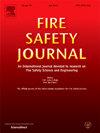Investigation and CFD simulation of coal dust explosion accident in confined space: A case study of Gaohe Coal Mine Ventilation Air Methane oxidation power plant
Abstract
The study investigates a coal dust explosion accident within a confined space in Shanxi. The accident was caused by coal dust coming into contact with a high-temperature heat source under the influence of the stack effect. Based on the investigation of the coal dust explosion accident, the study uses computational fluid dynamics (CFD) simulation to reconstruct the accident scenario. The simulation results provide a detailed depiction of coal dust movement within subsurface semi-enclosed confined spaces during the ventilation diffusion stage, influenced by the stack effect, and confirm the formation of a coal dust layer at the heat source due to coal dust deposition. The simulation results of the two explosion processes indicate that excessively high coal dust concentrations within confined spaces have a negative correlation with the development of explosion flames and the peak overpressure. It resulted in a secondary explosion with a relatively low concentration of coal dust, where the peak overpressure was five times that of the primary explosion. Comparative analysis between simulation results and actual investigations the accuracy of the CFD simulation in capturing the accident process and its characteristics, providing valuable insights for preventing and controlling coal dust explosion accidents.

 求助内容:
求助内容: 应助结果提醒方式:
应助结果提醒方式:


